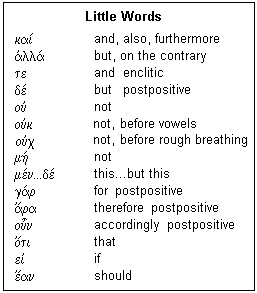Lesson ε': Little Words
 After all the complexity of nouns, adjectives and verbs, short simple words that do not have endings should be a great relief. The little words explained in this lesson are of very wide use, and most will appear in every proposition, so they are well worth knowing. They are shown at the right.
After all the complexity of nouns, adjectives and verbs, short simple words that do not have endings should be a great relief. The little words explained in this lesson are of very wide use, and most will appear in every proposition, so they are well worth knowing. They are shown at the right.
kai/ is stronger than the English "and". It's used not only to link things together in one sentence, but also to show that we are still dealing with the same subject in the next, where it often appears as the first word. To start a series of sentences with "and" is bad form in English, but not in Greek, where it shows a continuity of thought.
a)lla/ is stronger than the English "but", more like the German "sondern", to show a sharp contrast or contradiction. It marks a definite turn of thought. The final α is often elided before a following α.
The unaccented enclitic te is like the Latin -que, and is more like English "and". When used together with kai/, the combination means "and also". te...te means "both ... and".
de/ is like German "aber", weaker than English "but", and often not implying a contradiction at all, simply a slightly different thought or a change of subject. It never comes first in a phrase, usually following the first word. Such a word is called postpositive.
ou is the usual negative for a straightforward, indicative sentence. It does not carry an accent. Before a vowel, a κ is added, and before a rough breathing, a χ. Pronounce it as part of the next word in any case.
mh/ is the negative for all other cases. Imperatives, infinitives, subjunctives and participles are all negated with this word.
The combination me/n...de/ is very common when there are two phrases that naturally go together, often to make a contrast between them. It is very difficult to give an English translation, and the one shown is only the roughest approximation. Another possibility is: "on one hand ... on the other hand". Look out for examples of this to see how it is used. It is really a very common turn of phrase.
ga/r introduces a statement of fact that will be assumed in later argument. a/)ra introduces a conclusion based on facts that have been demonstrated, like Latin igitur. It is the equivalent of the three dots meaning "therefore" in mathematical symbolism. ou~)n is similar, but introduces something that follows naturally from the preceding argument. All these words are postpositive.
o/(ti simply introduces a clause depending on a verb. In Euclid, nearly every proposition states at one point: le/gw, o/(ti ..., or "I say that ...", giving the statement of the proposition in terms of the figure that has been drawn.
"If" is rendered by ei), and is followed by the indicative mood, provided that it is a universal condition, not one that may or may not be satisfied in different cases. In the latter case, e)a/n is used, and must be followed by the subjunctive. e)a/n is just ei) + a/)n, and it is the a/)n that demands the subjunctive. The word used for negation is different in the two cases, ou in the first, and mh/ in the second.
Return to Contents
Composed by J. B. Calvert
Created 11 September 2000
Last revised
 After all the complexity of nouns, adjectives and verbs, short simple words that do not have endings should be a great relief. The little words explained in this lesson are of very wide use, and most will appear in every proposition, so they are well worth knowing. They are shown at the right.
After all the complexity of nouns, adjectives and verbs, short simple words that do not have endings should be a great relief. The little words explained in this lesson are of very wide use, and most will appear in every proposition, so they are well worth knowing. They are shown at the right.